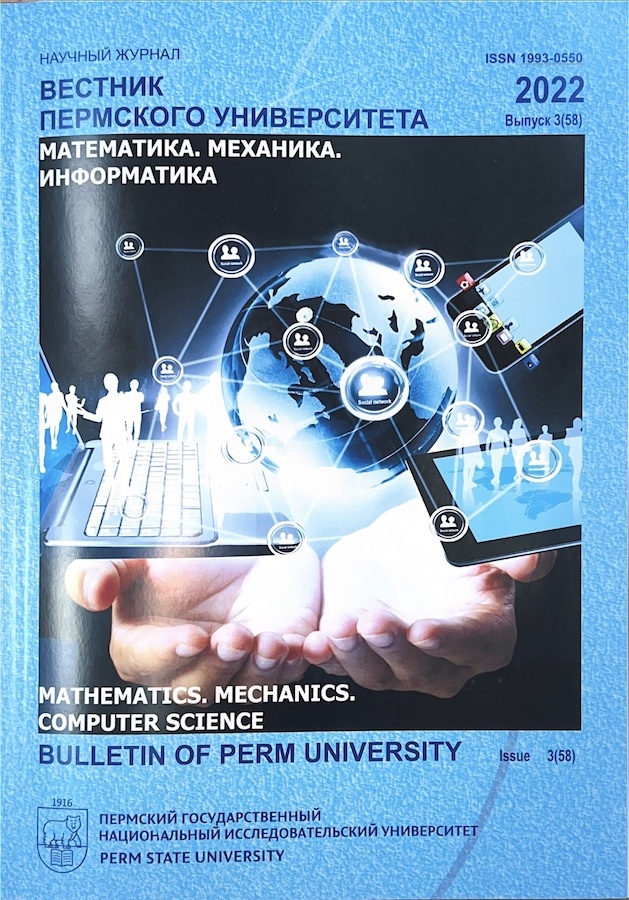A Net Virus Spreading in a Local Computer Network Modeling With Using Percolation Theory Methods
- 作者: Buzmakova M.M.1, Vorobyev E.A.1
-
隶属关系:
- Perm State University
- 期: 编号 2 (65) (2024)
- 页面: 54-60
- 栏目: Computer science
- URL: https://journal-vniispk.ru/1993-0550/article/view/307276
- DOI: https://doi.org/10.17072/1993-0550-2024-2-54-60
- ID: 307276
如何引用文章
全文:
详细
A net virus spreading in a local computer network is investigated in this paper. Two percolation models were proposed to describe two types of networks: wired and wireless. The percolation threshold corresponds to the fraction of infected computers in the network at which the network loses its operability. Algorithms for lattice filling by occupied nodes, for distributing occupied nodes into clusters, for searching a percolation cluster and for the percolation threshold determining were developed and implemented for the models. A numerical experiment was conducted to estimate the percolation threshold and its dependence on various virus characteristics.
作者简介
M. Buzmakova
Perm State University
编辑信件的主要联系方式.
Email: mbuzmakova@psu.ru
Candidate of Physical and Mathematical Sciences, Associate Professor 15, Bukireva St., Perm, Russia, 614068
E. Vorobyev
Perm State University
Email: teddehhh.study@gmail.com
first-year Master of Applied Mathematics and Informatics 15, Bukireva St., Perm, Russia, 614068
参考
- Penrose, S. (1959), "Se1f-reproducing machines", Scientific American, 1959, vol. 200, pp. 105-114.
- Burks, A.W. (1969), Von Neumann's self-reproducing automata, THE UNIVERSITY OF MICHI-GAN, 113p.
- Kliment'ev, K.E. (2013), Komp'yuternye virusy i antivirusy: vzglyad programmista, M.: DMK Press, 656 p.
- Minaev, V.A., Sychev, M.P., Vajc, E.V., Ki-rakosyan, A.E'. (2019), "Imitacionnoe modelirovanie e'pidemij komp'yuternyx virusov", Vestnik Rossijskogo novogo universiteta. Seriya "Slozhnye sistemy... ", no. 3, pp. 3-12.
- Semenov, S.G., Davydov, V.V. (2013), "Matematicheskaya model' rasprostraneniya kom-p'yuternyx virusov v geterogennyx komp'yu-ternyx setyax avtomatizirovannyx sistem upravleniya texnologicheskim processom", Vestnik NTU "XPI", no. 38, pp. 163-171.
- Gusarov, A.N., Zhukov, D.O., Kosareva, A.V. (2010), "Opisanie dinamiki rasprostraneniya komp'yuternyx ugroz v informacionno-vychislitel'nyx setyax s zapazdyvaniem dejstviya antivi-rusov", Vestnik MGTU im. N.E'. Baumana. Ser. "Priborostroenie", no. 1, pp. 112-120.
- Les'ko, S.A., Alyoshkin, A.S., Filatov, V.V. (2019), "Stoxasticheskie i perkolyacionnye modeli dinamiki blokirovki vychislitel'nyx setej pri rasprostranenii e'pidemij e'volyucioniruyushhix komp'yuternyx virusov", Rossijskij texno-logicheskij zhurnal, vol. 7, no. 3, pp. 7-27.
- Moore, C. and Newman, M. E. J. (2000), "Epidemics and percolation in small-world networks", Phys. Rev. E, no. 61, pp. 5678.
- Garetto, M., Weibo G. and Donald F. T. (2003), "Modeling malware spreading dynamics", IEEE INFOCOM 2003. Twenty-second Annual Joint Conference of the IEEE Computer and Communications Societies (IEEE Cat. No.03CH37428), no. 3, pp. 1869-1879.
- Hoshen, J., and Kopelman, R. (1976), "Percolation and cluster distribution: I. Cluster multiple la-beling technique and critical concentration algorithm", Phys. Rev. B, i. 14 (October), pp. 3438-3445.
- https://ru.wikipedia.org/wiki/Poisk_v_glubinu (accessed data: 20.04.2024).
- Matsumoto, M. and Nishimura, T. (1998), "Mersenne Twister: A 623-Dimensionally Equidistributed Uniform Pseudo-Random Number Generator", ACM Transactions on Modeling and Computer Simulation, vol. 8, no. 1, pp. 3-30.
- Stauffer, D. (1985), Introduction to percolation theory, London: Taylor & Francis, 192 p.
- Tarasevich, Yu. Yu. (2002), Perkolyaciya: teoriya, prilozheniya, algoritmy, M.: Editorial URSS, 112 s.
补充文件









